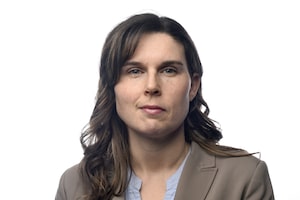As the best female hockey players packed up and left this year's world championship, they did so spreading a message.
Their game is getting better, they insisted, and women's hockey is worth the investment. Their progress can be agonizingly slow, they admitted, and sometimes you must look closely to see it. But they had cause for optimism.
Canada beat the United States in a 5-4 overtime thriller for gold, delivering a fast and physical brand of female hockey that dwarfs the level seen a decade ago. No one can touch the North Americans, who are developing at lightning speed with superior resources. That part hasn't changed, and it won't for some time. But a closer look at the whole picture shows forward motion.
This year's tournament showed the gap is closing between the teams jockeying for bronze, as Switzerland upset Finland 6-2 to win its first medal at the world championship. The tournament highlighted the significance of European players – especially goalies – coming to North America to develop.
"This will mean a lot to us in Switzerland to have this medal victory on TV and in the papers back home," said Swiss goalie Florence Schelling, who made 219 saves in the tournament and was named its most outstanding goaltender. "We had five days of practice together before this tournament. Compare that to how much the North American players had together. How good we could be if we were given more time together."
Several European goalies have flourished at U.S. colleges. Schelling plays at Northeastern University, Slovakia's Zuzana Tomcikova at Bemidji State University, and Finland's Noora Raty, who plays for the University of Minnesota, faced the highest number of shots in the tournament. The International Ice Hockey Federation was encouraged by the close scores between the European nations, and Finland even had a narrow 3-2 loss to Canada, thanks to a hot showing by Raty.
"The one place that college hockey has improved most in the past few years is goaltending, and look where many of these women are coming from," said U.S. coach Katey Stone, who also coaches at Harvard University. "That is revolutionizing the game. A great goalie means you're in the game. Sprinkle in a few more good players, and you're building a program. And those women take the experience home."
North American schools are considering European players more and more. There were 13 European players in this tournament who play for U.S. colleges, and three who play at Canadian universities. Many U.S. colleges have called Arto Sieppi, manager of the women's program in Finland, about players in an elite program he runs. The Finns are training high-school Olympic hopefuls in a full-time school setting. Finland encourages those players to then go to U.S. colleges.
The challenge is maintaining that level after graduation. Schelling, for example, will move to Montreal to vie for a spot with the Montreal Stars of the Canadian Women's Hockey League. But it doesn't change the plight of these women within their own nations, convincing teammates to train at an elite level, lobbying federations for resources.
Many used the media last week to call out federations. Canadian star Hayley Wickenheiser said Russia's hockey federation doesn't care enough about women's hockey to do what's necessary. Murray Costello, IIHF vice-president and tournament chairman, put pressure on Russia's "old boys' network" ahead of the 2014 Sochi Olympics, saying they are "under the gun." He urged nations to change their thinking.
"Some nations in Europe still don't think this is a game for women and aren't willing to give up the ice time to women," Costello said. "We're still trying to convince them. We [in North America]are about 20 years ahead of where they are. They are beginning to realize the women's game is not going away, so they better show some equality and opportunity developing it."
 Rachel Brady
Rachel Brady